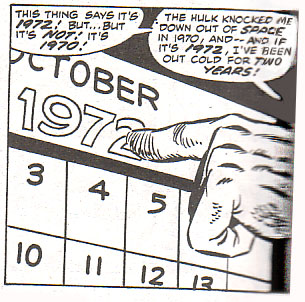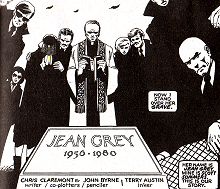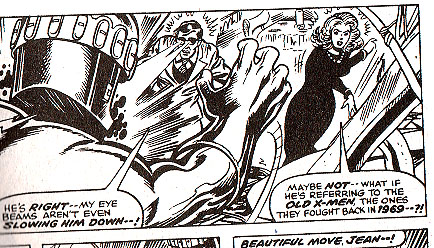







 |
 |
 |
 |
 |
 |
 |
 |
Comics sold best when they were linked to the real world. Specifically, the Second World War. Captain America does not just hit some nameless General who will change according to the sliding time scale: he hits Adolph Hitler. See the difference?

The silver age of comics
Marvel's most successful period, in terms of sales growth, marketable characters, and memorable stories, was the 1960s, when stories took place in real time.

Jerome Thomas writes:
"To my mind this is still the best example of successful real time storytelling in a mainstream American comic book and one of the best things Marvel has ever published."
"In the 1930s two Conan fans called Miller and Clark had used various clues in the original pulp stories (which followed no set order but skipped around various phases of Conan's life) to work out an outline of Conan's career and how all the stories fitted together. Roy Thomas used this outline, which spanned many decades, as a guide to his comic series. For example, if the Miller and Clark outline stated that Conan spent a couple of years as a Turanian army, then Roy Thomas would also spend a couple of years telling stories of Conan's adventures in the Turanian Service."
"Roy Thomas's original Conan run spanned 115 issues and was exactly 10 years long (October 1970-October 1980.) Over the course of those issues the hero aged 10 years. Unfortunately most of the writers who followed Roy were not interested in following any plan but were content to tell random unconnected stories about a changeless Conan killing one evil wizard after another. In short the series stopped being about a man's life. At its peak under Roy Thomas, Conan was a critical and commercial success winning numerous industry awards and outselling every other Marvel character except for Spider-Man. Once real time and progress vanished so did the readership."
Englehart's Captain America dealt with Watergate, racism, America's self image and other hot issues of the time. It's still considered one of the greatest Captain America runs ever. All of Englehart's books referred to real time, and are remembered as high points of the 1970s comics. Later, in the 1980s, Englehart came back, but Marvel would not let him use real time elements, so his 1980s stories were generally not as good.

The biggest success of the 1970s - the only characters to become as big as the those created in the real time 1960s - were the new X-Men. They were full of real time references. The new X-Men were dominated by permanent change and the passage of time. The old team grow old and retire, and several die (Thunderbird, Banshee, Phoenix). In issue 99 the main story is introduced by Geraldo on TV, and Colossus’ history is tied to the Apollo 1 fire (all by page 3!). The origin of Ororo (issue 102) says she was born in 1951, and then it refers to events "five years later" in 1956 during the Suez crisis. In issue 113 the main story is introduced by the BBC's John Cheever. In issue 105 Claremont and Cockrum appear in the comic. In issue 108 the president is clearly Jimmy Carter. One of the most popular stories, Days of Future Past, was clearly dated to Oct. 31 and Nov. 1, 1980. In issue 117. Xavier looks back over he passage of time and decides to retire. The stories take place in recognizable locations: New York, other US states, Canada, Ireland, Scotland, Antarctica, Greece, the southern tip of South America, Japan, Australia and New Zealand. The passage of time is often mentioned, and the past is never forgotten. For example, issue 119 refers to both of Moses Magnum's previous apparent deaths. The passage of time was everywhere.
 |
 |
The 'Nam
"... a twelve year limited series. it was their intention to produce one issue for every month the United States had been in Vietnam. They planned for the book to occur in real time, so each issue detailed another month in the characters' lives. ... Some veterans were pleased, others thought it trivialized their experiences. Sales, however, were excellent and the series ran for eighty-four issues [i.e. 12 years exactly as planned, when most new comics fail in their first year]" - Marvel Chronicle, p.229 (on1986).The biggest hits of the 1980s and later
Real time became less and less common with time. The only breakout hits of the 1980s, the issues that spawn movies and are still juggernauts today, are the DC comics Dark Knight Returns and Watchmen. Both are about the passage of time. Watchmen puts precise dates by many of its stories, though it is an alternate history.The only other comic that people still talk excitedly about is Kurt Busies and Alex Cross's "Marvels," a book that places all Marvel stories squarely into real time.
Years later Claremont returned to the X-Men, Marvel no longer allowed real time references. The later stories lack the realism and readers complain that Claremont's powers have declined. But the pressure for real time won’t go away. Marvel.com recently ran a web poll for fans to choose “Claremont’s Next X-Men Project.” Guess what idea won? That’s right, a real time series to see what happens when the heroes grow up.
It's too soon to say which comics from the 2000s will have a lasting impact, but judging by fan reactions, some stand out as special. What they have in common? The passage of time. For example, AJ Hall wrote:"Brian K Vaughan's 2003-05 Runaways managed to run far away from Marvel Time. BK is the present-day master of single-issue stories, and Runaways has incredible pacing to show for it. ...it's really something of a solitary window into what the entire Marvel Universe could have been like by now if only the long-time heroes had been allowed to age and gradually step out of the limelight to make room for a brand-new, younger crowd. It's exciting and relevant, like anything set in the real Marvel Universe is supposed to be!"
Other small hits are Kick Ass; a story saturated in real time references, where YouTube and eBay and Facebook feature strongly; and the Wildstorm universe, which thanks to Jenny Quantum (a character who represents each century and has a prominent real time birthday), is tied to real time.
From Wikipedia: "One aspect of the Love and Rockets opus is the way Los Bros Hernandez portray the passage of time in a relatively realistic manner despite the traditional constraints of the medium. For example, Maggie's character debuted as a slight yet curvy young adult mechanic. [0ver the years] she started to gain weight [...] The present Maggie is now the manager of an apartment complex with bleached blond hair and a penchant for wearing sexy bathing suits on her rubenesque figure. Jaime has also made extensive use of flashbacks, with Maggie and the others presented at different ages from toddlers through teenagers and young adults to thirty-somethings. The first issue of volume two of Love and Rockets featured a cover with a range of different Maggie ages/looks."
Larsen is an interesting case because he has a real time comic, but argues that mainstream heroes should not be real time. This is kind of like how Stan Lee created a whole series of real time comics, then decided to ditch real time (in the late 1960s) and watched sales decline.
The most successful British comic book character of the last generation is Judge Dredd. His stories take place in real time. As one fan reminded me,
"2000 AD has always run in real time since it's founding in 1977. You've certainly heard of Judge Dredd but you may not be aware that the man is now seventy years old and unlike many American comic characters, he is actually starting to show it. In fact many fans have been discussing the imminent death of Britain's most popular comic character. And you know that once he's dead that will be it, like Strontium Dog in 1990. That makes it an exciting time to be a Judge Dredd fan."Japanese Manga are the world's most successful comics. As one fan explains, the passage of time is a big part of that:
"I think this is the single most advantage manga has over American comics: people age and stories end. ... Sure manga has other advantages like being more easy to jump-on and more diversity of genres (even if inside the genres are sometimes even more rigid than superheroes comics), but this one is the biggest. I think Neil Gaiman said best: all good stories have to end sometime."
Gasoline Alley
If you look at a history of the earliest comics, starting with the Yellow Kid, Krazy Kat and the rest, they have all gone. Until you get to Gasoline Alley, started in 1919. Why did Gasoline Alley survive when others did not? Gasoline Alley is set in real time and so is always relevant.
For Better or Worse
Lynn Johnston's "For Better or Worse" is one of only five strips that syndicate to more than 2,000 newspapers. Its real time is just a natural result of caring about realism. "I didn't intend for everybody to grow up," Johnston said. "They just did."
Doonesbury is another of those handful of strips that syndicates
in thousands of newspapers. And here again it exists in (more or
less) real time.
Is it just coincidence that real time works?
If you want to understand great stories, read "How to Write a Damn Good Novel" by James N. Frey: